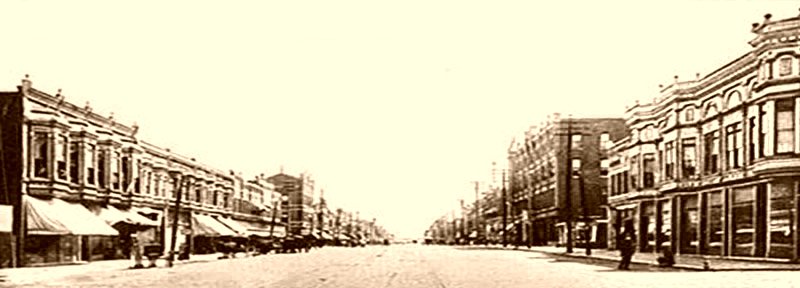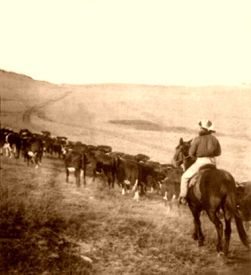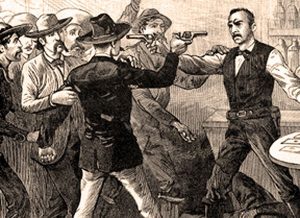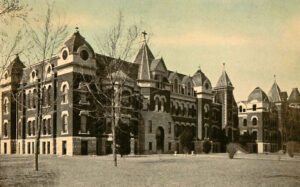Delano, Kansas, once another rowdy Kansas cowtown, is now a historic neighborhood of Wichita in Sedgwick County.
After the Homestead Act was passed in 1862, several settlers purchased land on the west bank of the Arkansas River across from Wichita. These settlers named their new community Elgin.
In 1870, Elgin became a cattle shipment point on the Chisholm Trail and began to grow. In February of 1871, J.E. Martin formed the Elgin Town Company, which a month later was renamed the Delano Town Company because there was already a Kansas town named Elgin. It was named after Columbus Delano, Secretary of the Interior under President Ulysses S. Grant. A post office was established on April 5, 1871, and the town was platted the next month. That year, C.M. Jennison and I.C. Walker opened a hotel, advertising “first-class saloon connected, where the finest wines, Liquors, Cigars, Tobacco, etc. can be found… Good stabling and the best Corral in the Country for Horses and Cattle.” The town was never incorporated.
Soon, hotels, saloons, and other new businesses opened, and a toll bridge was built across the river to Wichita. In 1872, Delano boasted 18 buildings, including two blacksmith shops, a wagon shop, a paint shop, a saloon, two boarding houses, and three feed stables.
Catering to the many cowboys driving cattle from Texas to railheads in Kansas, the town soon boasted more saloons, several brothels, and gambling houses. As the cowboys blew off steam after the long cattle drive, Delano became a center of drinking, gambling, and prostitution and gained notoriety as one of the wildest cow towns in the Old West. Brawls and gunfights were frequent, cattle rustling was common, and with no sheriff to oversee the town, vice and violence ran rapid.
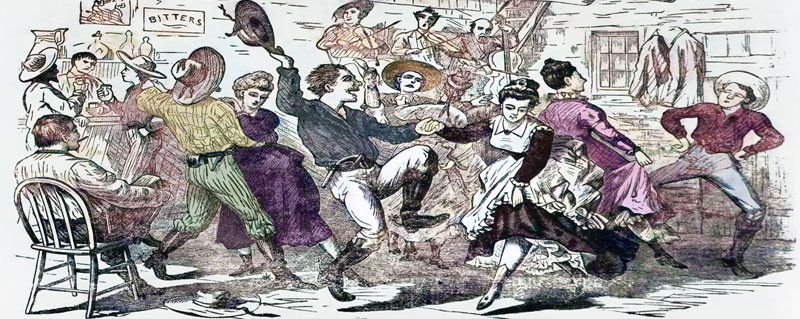
Rowdy dance house.
During the town’s height of rowdiness, the “soiled doves” or “painted ladies” did a brisk business. In 1872-73, an event called the Running of the Doves took place where the women were loaded in wagons, taken to the Arkansas River, removed their clothing, and raced back to the saloons on foot. Lining their path were cowboys and customers, cheering them on and betting on the winners.
Gunfights occurred as well, including a fatal and locally famous incident between two saloon keepers in 1873. Just northwest of the Douglas Street bridge, built in the 1870s, two neighboring saloons fanned a flame of rivalry between their owners. “Rowdy Joe” Lowe and his wife Rowdy Kate owned one establishment while the other was owned by Edward T. “Red” Beard. Red became jealous of Rowdy Joe’s success and started a shootout on On October 27, 1873. In the end, Lowe opened fire, wounding Beard, who died on November 11.
By 1876, the cattle trade had relocated west to Dodge City, and Delano’s period as a rowdy cowtown ended.
Delano was annexed into the city of Wichita in 1880. At that time, it had 504 residents. Its post office closed on December 6, 1880, and the neighborhood became locally known as West Wichita.
In the next years, new businesses opened, including a watch factory, and business blocks were built. The area also attracted agricultural businesses such as the Fort Scott Grain Elevator and nine flour, feed, hay, and grain stores. New industrial businesses included five lumber dealers, the Elliott Planing Mill, and the Crystal Ice Dealer.
The boom of the 1880s also gave rise to institutes of higher learning. The first was the establishment of Garfield University in 1886. All Hallows Academy, a Catholic girl boarding school, was established in 1887. It was operated by a branch of the Sisters of Charity of the Blessed Virgin Mary out of Dubuque, Iowa.
However, the building boom soon gave way to a bust. During an economic downturn in the 1890s, many early developers and businessmen lost their money. In 1890, Garfield University closed. However, it was purchased in 1897 and soon became Friends University, which still exists today.
In the early 1900s, the neighborhood began to grow again with renewed improvements in manufacturing and the oil industry.
In 1901, the Sisters of Charity of the Blessed Virgin Mary renamed All Hallows to Mount Carmel Academy due to the negative connotation associated with the purely secular holiday of Halloween.
In 1903, the Kansas City, Mexico, and Orient Railroad reached Wichita and went through the southwest part of the city. The addition of the Orient Railroad gave West Wichita four railroads but no depot.
In Wichita’s early days, there was a 56-acre island in the middle of the Arkansas River known as Ackerman’s Island, named for the owner Joseph Ackerman. The island extended from close to the confluence of the Big and Little Arkansas Rivers almost to the Douglas Street Bridge. In 1905, the Wichita Amusement Park Company opened “Wonderland Park” on the island, which was to be “the Coney Island of the West.” The attractions included a Coliseum that could seat 2,500 people. The park also provided a roller skating rink, a carousel, the longest roller coaster in the country, billiard hall, bowling alley, a baseball field, the Irish Cafe, Cessna’s Tour of the World, carnival rides, a penny arcade, a Fun Factory, dancing pavilion, and the Wonderland Park Theater. The bandstand brought in various shows and performances, including acrobats, opera singers, animal acts, and big-name performers of the day. A big electric sign near the south side of the island could be seen the length of Douglas Street to College Hill. More than 200,000 visitors came during the opening year to pay the quarter admission fee and enjoy the attractions.
Wonderland Park operated from 1905 until about 1918. After that, the island was used by industrialists.
In the meantime, the Kansas City, Mexico, and Orient Railroad built a roundhouse and repair shops at Hiram and Harry Streets, and the Midland Valley Railroad opened a depot in 1911 on West Douglas Avenue near the Arkansas River. A new Douglas Avenue bridge and the extension of a streetcar line to Seneca made local transportation easier.
From the 1910s to the 1920s, West Wichita saw another building boom due to oil interests and the increase in infrastructure. Many of the area’s historic buildings were built during this time.
In the 1920s, Wichita became a center of aircraft manufacturing, and several companies opened facilities in the Delano neighborhood. These included Travel Air in 1925, Cessna in 1927, and several smaller companies.
By 1930, West Wichita was starting to decline. Several factors led to the decline, including the Midland Valley Railroad going bankrupt in 1931, the rise of the University of Wichita (now Wichita State University), and the start of the Great Depression.
At that time, flooding had become a problem along the Arkansas River, and the Works Progress Administration recommended getting rid of the sandbar to widen the river. In 1933, 1,500 unemployed men were put to work for 1.5 years using pickaxes, shovels, and wheelbarrows. The Ackerman Island sandbar then became part of the west bank of the current river.
The Works Progress Administration also built the Lawrence Athletic Field in 1934. Many semi-pro games were played at the park and the NBC tournament (National Baseball Congress) was held each summer. The stadium was renamed Lawrence-Dumont Stadium in 1978. In 2018, the stadium was demolished and replaced by the Riverfront Stadium, which opened in the Spring of 2021.
In the 1950s and 1960s, businesses and retailers began to leave the neighborhood because the aircraft industry had relocated elsewhere in the city.
In 1961, Mount Carmel Academy moved from its location on West Douglas to the Vickers home and property on East Central. The old structures then became home to an all-boys school called Notre Dame in 1962. However, it closed in 1964, and the old buildings were torn down in 1965. West Wichita’s only railroad depot, the Midland Valley Depot, was torn down to make room for the Metropolitan Baptist Church. In the next years, more buildings were torn down due to neglect and Urban Renewal. The old Wichita Hospital on the northwest corner of Douglas Avenue and Seneca Street was demolished in 1972.
By the 1990s, the area had entered a period of modest decline. However, by 2000, neighborhood organizations and the city government collaborated to develop and implement a revitalization plan.
Delano’s business district has become a booming local shopping and entertainment area marketed as the Historic Delano District. The area is home to Friends University, Riverfront Stadium, and Exploration Place, the Sedgwick County Science Museum.
It is located across the river, west of Downtown Wichita.
©Kathy Alexander/Legends of Kansas, updated October 2022.
Also See:
Sources:
The Active Age
Historic Delano
Visit Wichita
Visit Wichita – 2
Wikipedia

